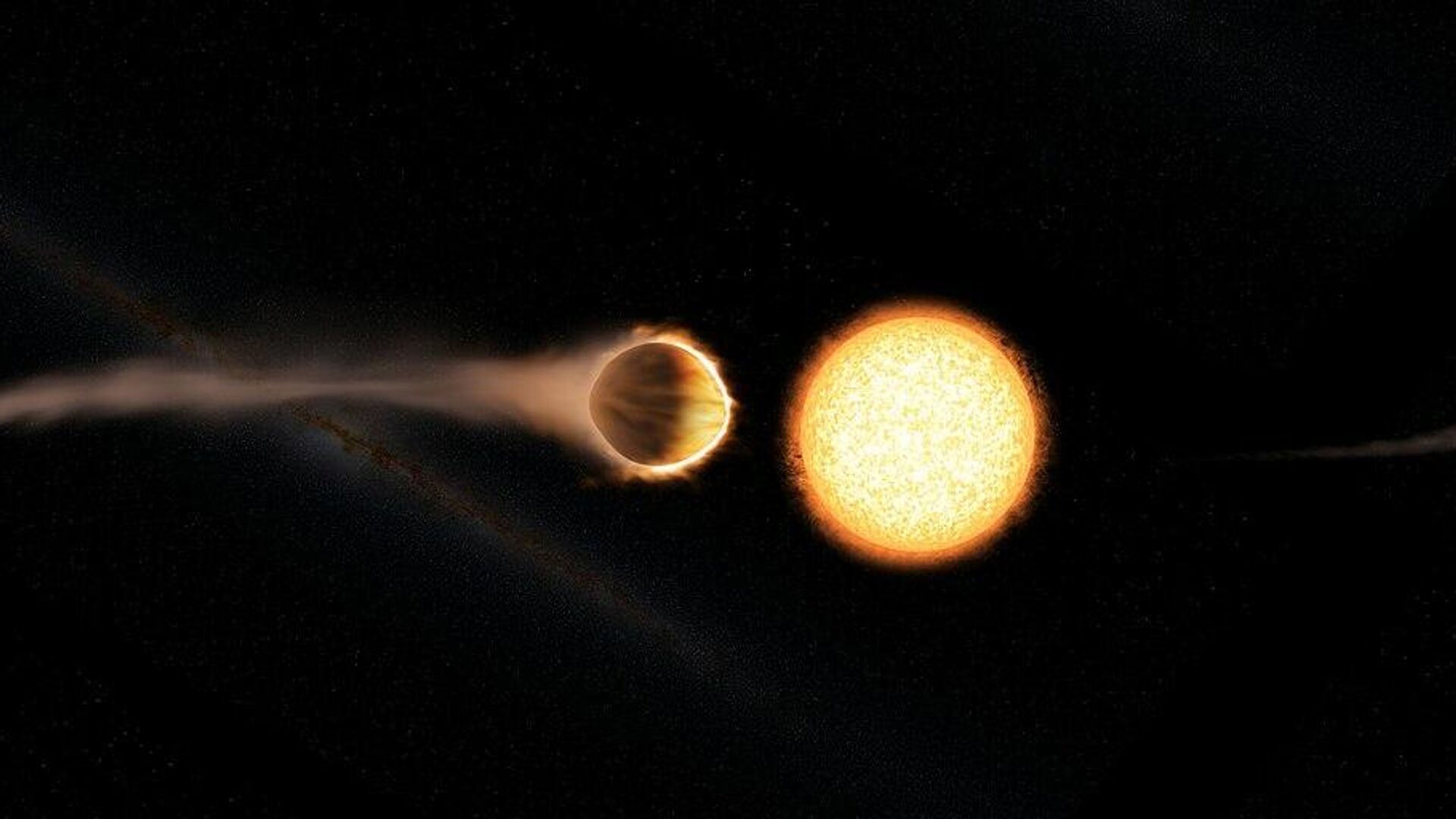https://sputnikglobe.com/20220222/jupiter-like-planet-outside-solar-system-has-metal-clouds-which-could-rain-precious-liquid-gems-1093258383.html
Jupiter-Like Planet Outside Solar System Has Metal Clouds Which Could Rain Precious Liquid Gems
Jupiter-Like Planet Outside Solar System Has Metal Clouds Which Could Rain Precious Liquid Gems
Sputnik International
Discovered in 2015 , the exoplanet WASP-121b is believed to be orbiting a star that's nearly 850 light-years (a light-year is equal to 9.4 trillion kilometres)... 22.02.2022, Sputnik International
2022-02-22T09:34+0000
2022-02-22T09:34+0000
2022-11-03T19:33+0000
astronomy
astrophysics
massachusetts institute of technology (mit)
hubble space telescope
nasa
sun
solar system
emerald
science & tech
earth
https://cdn1.img.sputnikglobe.com/img/07e6/02/16/1093262531_57:0:967:512_1920x0_80_0_0_40397a2349fc915a740f68f867dd10c9.jpg
WASP-121b, an ultra-hot planet outside the solar system, has metal clouds and rain composed of liquid gems, a new study led by astronomers from the Massachusetts Institute of Technology (MIT) has found.Twice the size of Jupiter, WASP-121b is known to be "tidally locked", meaning it shows just one side of itself to the star it orbits. Further, temperatures on its day side are known to average around 3,000 Kelvin due to the comparative shorter distance between the planet and its star.Scientists also uncovered that the exoplanet has one of the shortest orbits, taking just around 30 hours to complete a revolution around its star.The MIT release states that the images of the planet were obtained via a spectroscopic camera aboard NASA's Hubble Space Telescope.The findings were also published in the peer-reviewed scientific journal Nature Astronomy on 21 February.While the presence of water vapour on the exoplanet has been known through previous observations, the new study has revealed the patterns through which water circulates between its day and night sides.The hydrogen and oxygen atoms, which constitute water, are broken down on the exoplanet's day side due to high temperatures, after which they float to its relatively cooler (still much higher temperatures than those found on Earth) dark side, as per the study.Once the broken-down water molecules reach the dark side, hydrogen and oxygen atoms combine again to form water molecules, which then float again to the side perpetually facing the star. This to-and-fro cycle keeps repeating itself.As per researchers, the exoplanet's water cycle is sustained by winds blowing at speeds of up to 5 kilometres per second, or more than 11,000 miles per hour.Corundum is a constituent in precious stones such as rubies and sapphires. Scientists say that these metal clouds could also travel to the day side, where they are bound to be vapourised due to high temperatures and thus produce exotic rains made of liquid gems."We're now moving beyond taking isolated snapshots of specific regions of exoplanet atmospheres, to study them as the 3D systems they truly are", says Thomas Mikal-Evans, an MIT researcher and the lead author of the study."With this observation, we're really getting a global view of an exoplanet's meteorology", Mikal-Evans also remarked.Extreme Temperature DifferencesThe new study also maps the temperature profiles on WASP-121b's day and night side, finding the temperatures on the region facing the star vary between 2,500 and 3,500 Kelvin.While the temperatures on the planet's day side rose with altitude, they decreased with height on the night side, as per researchers.Researchers also claim that high wind speeds on the planet "could probably move clouds" across the celestial object in around 20 hours, despite its massive size.Further, the researchers involved in the project claim that WASP-121b could also have traces of carbon monoxide, a proposition they will investigate later this year through the James Webb Space Telescope.
https://sputnikglobe.com/20211015/exoplanet-flooded-by-global-ocean-may-have-potential-to-sustain-life-claim-new-studies-1089949016.html
earth
Sputnik International
feedback@sputniknews.com
+74956456601
MIA „Rossiya Segodnya“
2022
News
en_EN
Sputnik International
feedback@sputniknews.com
+74956456601
MIA „Rossiya Segodnya“
Sputnik International
feedback@sputniknews.com
+74956456601
MIA „Rossiya Segodnya“
astronomy, astrophysics, massachusetts institute of technology (mit), hubble space telescope, nasa, sun, solar system, emerald, science & tech, earth
astronomy, astrophysics, massachusetts institute of technology (mit), hubble space telescope, nasa, sun, solar system, emerald, science & tech, earth
Jupiter-Like Planet Outside Solar System Has Metal Clouds Which Could Rain Precious Liquid Gems
09:34 GMT 22.02.2022 (Updated: 19:33 GMT 03.11.2022) Discovered in 2015 , the exoplanet WASP-121b is believed to be orbiting a star that's nearly 850 light-years (a light-year is equal to 9.4 trillion kilometres) away from Earth. To put the distance in context, the distance between the Earth and the Sun is approximately 150 million kilometres.
WASP-121b, an ultra-hot planet
outside the solar system, has metal clouds and rain composed of liquid gems, a new study led by astronomers from the Massachusetts Institute of Technology (MIT) has found.
Twice the size of Jupiter, WASP-121b is known to be "tidally locked", meaning it shows just one side of itself to the star it orbits. Further, temperatures on its day side are known to average around 3,000 Kelvin due to the comparative shorter distance between the planet and its star.
Scientists also uncovered that the exoplanet has one of the shortest orbits, taking just around 30 hours to complete a revolution around its star.
While astronomers have been studying the exoplanet's "day side" since 2015, the new study is based on images showing the "clearest view yet of the perpetual dark side", as per a press release by MIT's Kavli Institute for Astrophysics and Space Research.
The MIT release states that the images of the planet were obtained via a spectroscopic camera aboard
NASA's Hubble Space Telescope.
The findings were also published in the peer-reviewed scientific journal Nature Astronomy on 21 February.
"Hot Jupiters are famous for having very bright day sides, but the night side is a different beast. WASP-121b's night side is about 10 times fainter than its day side", says Tansu Daylan, an MIT postdoctoral researcher and a co-author of the study.
While the presence of water vapour on the exoplanet has been known through previous observations, the new study has revealed the patterns through which water circulates between its day and night sides.
"While on Earth, water cycles by first evaporating, then condensing into clouds, then raining out, on WASP-121b, the water cycle is far more intense…", the researchers state in the new study.
The hydrogen and oxygen atoms, which constitute water, are broken down on the exoplanet's day side due to high temperatures, after which they float to its relatively cooler (still much higher temperatures than those found on Earth) dark side, as per the study.
Once the broken-down water molecules reach the dark side, hydrogen and oxygen atoms combine again to form water molecules, which then float again to the side perpetually facing the star. This to-and-fro cycle keeps repeating itself.
As per researchers, the exoplanet's water cycle is sustained by winds blowing at speeds of up to 5 kilometres per second, or more than 11,000 miles per hour.
Interestingly, the darker side of the planet is found to be cold enough to host "exotic clouds" of iron and corundum, the study says.
Corundum is a constituent in precious stones such as rubies and sapphires. Scientists say that these metal clouds could also travel to the day side, where they are bound to be vapourised due to high temperatures and thus produce exotic rains made of liquid gems.

15 October 2021, 13:13 GMT
"We're now moving beyond taking isolated snapshots of specific regions of
exoplanet atmospheres, to study them as the 3D systems they truly are", says Thomas Mikal-Evans, an MIT researcher and the lead author of the study.
"With this observation, we're really getting a global view of an exoplanet's meteorology", Mikal-Evans also remarked.
Extreme Temperature Differences
The new study also maps the temperature profiles on WASP-121b's day and night side, finding the temperatures on the region facing the star vary between 2,500 and 3,500 Kelvin.
For the dark side, the temperatures were detected to range between 1,500 to 1,800 Kelvin (1,200 to 1,500 degrees Celsius).
While the temperatures on the planet's day side rose with altitude, they decreased with height on the night side, as per researchers.
Researchers also claim that high wind speeds on the planet "could probably move clouds" across the celestial object in around 20 hours, despite its massive size.
Further, the researchers involved in the project claim that WASP-121b could also have traces of carbon monoxide, a proposition they will investigate later this year through the James Webb Space Telescope.
"That would be the first time we could measure a carbon-bearing molecule in this planet's atmosphere. The amount of carbon and oxygen in the atmosphere provides clues on where these kinds of planet form", states Mikal-Evans.


